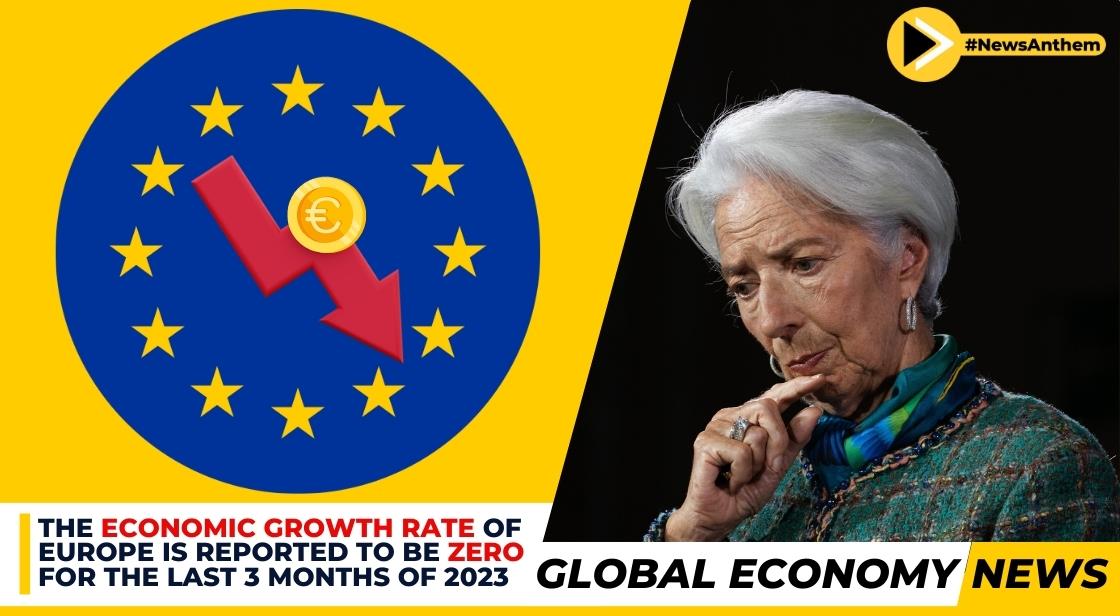Stagnation in Focus: European Economy Registers Zero Growth in Q4 2023

News Synopsis
Introduction- Eurozone's Economic Standstill: Analyzing the Zero Growth
As 2023 drew to a close, Europe's economic landscape presented a challenging picture, marked by stagnation and uncertainty.
The Eurostat report revealed a startling halt in economic growth, with Europe’s economy failing to expand in the final quarter of the year.
This period of zero growth is not just a standalone statistic but a continuation of a worrisome trend that has been affecting the region for more than a year, influenced by factors like escalating energy prices, costlier credit, and significant downturns in key economies like Germany.
Europe's Economic Stagnation: A Deep Dive into the Zero Economic Growth Rate Theory
The final quarter of 2023 saw Europe's economy stagnate, an alarming sign for a region that has long been a cornerstone of global economic stability.
This stagnation follows a marginal contraction of 0.1% in the preceding quarter, painting a bleak picture of continuous economic woes.
The Eurozone, comprising 20 countries using the euro currency, has been trapped in this sluggish phase since the third quarter of 2022 when the economy grew only by 0.5%.
For a detailed analysis of this economic trend, Capital Economics offers insightful commentary on the eurozone’s growth patterns.
Global Trade Disruptions and Impact on Europe
The European economy's stagnation is further exacerbated by global trade disruptions. One significant factor has been the disturbances in the Red Sea shipping routes, particularly through the critical Suez Canal, a major artery for trade between Asia and Europe. These disruptions have led to surging shipping costs, contributing to the already inflating prices within the region. The ripple effects of these increased costs have been felt across various sectors, posing a significant threat to Europe's economic stability. In-depth coverage of these disruptions can be found in Oxford Economics’ reports.
Europe vs. United States: Economic Divergence
The economic trajectories of Europe and the United States in the same period present a study in contrast.
While Europe grappled with stagnation, the U.S. Economy exhibited growth, expanding by 0.8% in the fourth quarter, translating to an annual pace of 3.3%.
This divergence highlights the varying impacts of global economic pressures and the differing policy responses in these regions.
For a comparative analysis of Europe's and the U.S.'s economic strategies, The Economist offers a comprehensive perspective.
Silver Linings Amidst Economic Challenges
Despite the grim economic landscape, there are a few positive indicators.
The unemployment rate in Europe is at record lows, and job growth has been observed, especially in the third quarter of the year.
Additionally, energy prices, while still higher than pre-crisis levels, have seen a reduction from their recent peaks.
Furthermore, robust storage levels of natural gas in Europe have somewhat alleviated fears of a major energy crisis, providing a glimmer of hope in an otherwise bleak economic scenario.
The Road Ahead: Predictions and Economic Policies
Looking ahead, the start of 2024 does not bode well for a rapid economic turnaround in Europe. Economic indicators suggest the potential for a slight contraction in the early months. However, economists at Oxford Economics opine that falling inflation could restore consumer purchasing power, potentially aiding economic recovery.
The European Central Bank's (ECB) monetary policy, particularly its decisions on interest rates, will play a crucial role in shaping the region's economic trajectory. While some analysts anticipate a rate cut as early as April, others suggest a more cautious approach, waiting until June to ensure inflation is firmly under control.
For further insights into the ECB's policy decisions, refer to Bloomberg’s coverage.
News Final Sum-up: Europe's economic performance in the last quarter of 2023 serves as a stark reminder of the challenges facing the region.
The zero growth rate underscores the need for strategic economic policies and interventions to steer Europe back onto a path of sustainable growth.
While the immediate future appears uncertain, the actions taken by policymakers and the resilience of the European economy in the face of these challenges will be critical in determining the region's economic fate in the coming months.
You May Like









